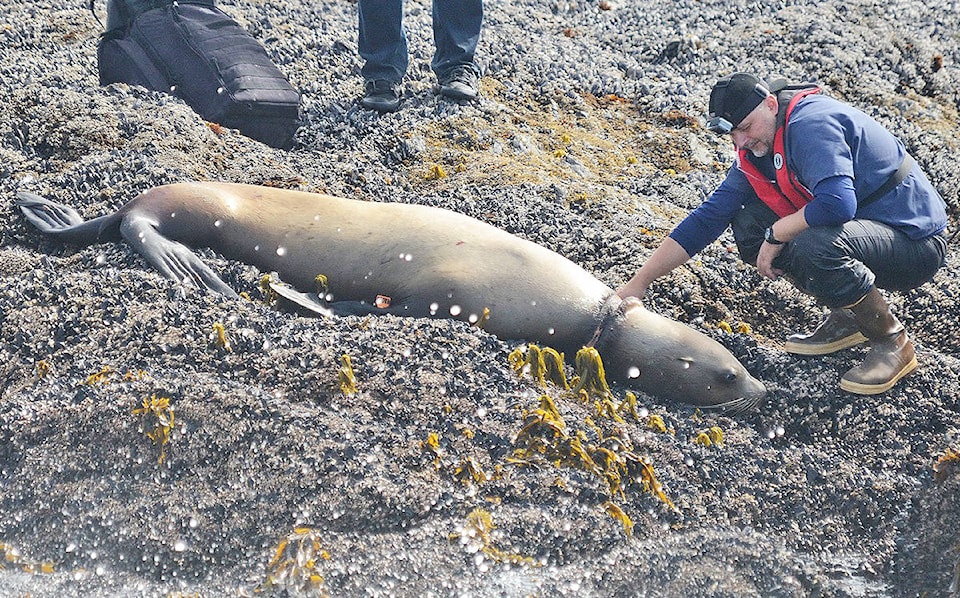The Vancouver Aquarium’s head veterinarian Dr. Martin Haulena might not wear a cape, but he’s definitely a hero after swooping in to rescue an entangled sea lion near Tofino on July 9.
An adult female Steller sea lion was facing a painful and slow death after getting caught up in marine debris on Cleland Island.
Haulena told the Westerly News that the large animal had a piece of garbage tightly wrapped around her neck that had cut deep into her skin.
“She was skinny. I do believe she was already being compromised in terms of her ability to go and forage,” he said. “Eventually this would have been the death of her. One of the major issues, for me in particular, is how long that takes. It’s an absolutely horrible way to go. It’s months or upwards of a year to succumb to these kind of injuries, They just don’t get better. The entanglement that’s there just keeps cutting and cutting and hurting and hurting.”
The distressed sea lion had been spotted by several wildlife watching companies in the area and reported to the Vancouver Aquarium Marine Mammal Rescue Centre prompting Haulena’s team into action.
Haulena was taken to the site by local adventure company Ocean Outfitters and was joined in the rescue effort by DFO and Parks Canada personnel as well as local researcher Wendy Szaniszlo, and Doug Sandilands, from Washington State rescue organization.
When the team arrived at the site, Haulena was unable to shoot the distressed animal with a tranquilizing dart from the boat due to rough seas and the crowd of sea lions around the distressed one, so he and several other team members got onto the island.
“I just kind of snuck out along the rocks to the haul out site and got a really good vantage point on a little high spot right beside the animal and waited for a good opportunity when the other animals got out of the way and then just took the shot.”
Once the animal was sedated, the next step was to approach her without upsetting the other animals.
“We approached from such an angle so the animals are moving away from her when they’re going into the water and clearing out of the way,” he said. “They are pretty good about moving off as long as you don’t try to antagonize them or anything…For the most part, they’re quite fearful and watchful, they stay close and they’re very curious, but they don’t tend to be very aggressive.”
Once at the animal, Haulena made quick work of removing the trash around its neck.
“She was a little bit close to the water, so we had to work a bit more quickly than in some other cases because the tide was coming in and there was a good wash happening there,” he said.
“The disentanglement itself was very, very, quick and there was about an 8-10 minute recovery time and, of course, we want to collect some samples and put some flipper tags on the animal so we can identify her later.”
He said the sea lion “was back in the water and acting very normal,” within 20 minutes of being freed from the debris and has been spotted by several whale watch groups since the rescue.
“Once you get that material off of them, they do heal very well,” he said.
He said the rescue was a solid collaborative effort between his team, DFO, Parks Canada, BC Parks and, he added, local wildlife watching companies played an integral volunteer role in the mission.
“The kept an eye on it for a few days, made sure it was staying put and that there was a good chance it would be in the area by the time we could get our team together, get our weather window and get out there,” he said. “Ocean Outfitters was absolutely phenomenal. They donated their boat and captain to take us out there and spend a good chunk of the day with us and they monitored the animal before and after this with some other whale watching folks. It’s just so nice to see so many people from so many different situations just really care about animals and, you know, that makes me feel good.”
Haulena said marine debris entanglement is a chronic problem and noted local marine mammal researcher and Vancouver Aquarium associate Wendy Szaniszlo estimates roughly 400 sea lions are entangled in debris within the Pacific Rim Nation Park—between Tofino and Ucluelet—each year.
“That’s a high number and, unfortunately, we can’t get to all of them,” he said. “It’s a major effort. We’re super lucky we can get six animals a year.”
Discarded fishing gear, like nets and rope along with trash like plastic shipping straps, can easily become fatal snares around an animal’s neck and Haulena hopes to see more people get onboard a ‘Loose the Loop’ mentality to cut down on the number of man-made hazards animals face.
There’s a lot of folks out there trying to get that message out,” he said adding tag lines like ‘Loose the Loop’ are spread far and wide. “It’s out there but, I think, if people don’t want to listen, they’re not going to find it.”
West Coast locals and visitors are urged to never approach a distressed sea lion and to, instead, immediately report any sightings to Vancouver Aquarium’s Marine Mammal Rescue Centre at 604 258 7325.



